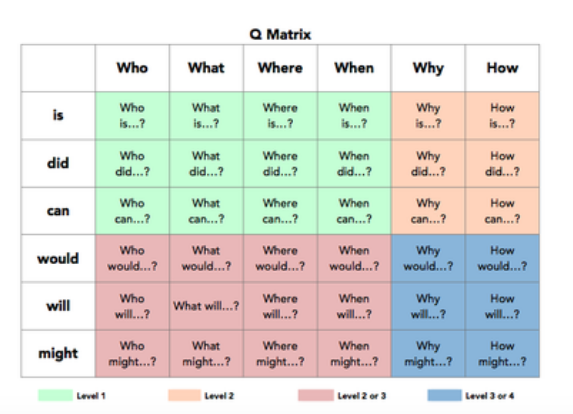The Question Matrix is a useful tool to introduce a hierarchy of thinking. These relate to Blooms Taxonomy and is an element that is important to incorporate in education and our questioning strategies. The matrix is a visual representation of how to build stronger, higher order thinking questions. Creating questions with the prefix of examples in the upper left quadrant (level 1) are questions that often require lower order thinking, and produce superficial answers. The goal is to ask the questions at the bottom right corner of the matrix. These questions require high order thinking to produce answers that are deeper than surface level knowledge.

As we start at the top left corner, questions using “what is” represents the lower level thinking. Here’s an example:
“What colour is the sky?”
Answer: “The sky is blue.”
These are known as literal questions and require basic visual representation of the information.
Next, are inferential questions where students are required to infer or find hints from the information:
“Where would the sky get its blue colour from?”
Answer: “ Possibly from water… water is blue, reflective…Maybe out of space? Something to do with the sun? Sky is only blue in the day, not at night..”
As we move towards the bottom right corner, the same concept can be worded in a manner that encourages higher thinking, and requires more in-depth thinking, questioning and solving.
“Why might the sky be blue?”
“How might the sky be blue?”
Answering these questions will take research, multiple levels of thought and comprehension. It’s not about answering the question in as little words or as quick as possible, but going through the process of finding the answer:
A Google search turns up that (according to NASA) “Sunlight reaches Earth’s atmosphere and is scattered in all directions by all the gases and particles in the air. Blue light is scattered in all directions by the tiny molecules of air in Earth’s atmosphere. Blue is scattered more than other colors because it travels as shorter, smaller waves.”
This solves the question and provides an answer, but what’s even better is it proposes more questions than it solves: “ What colour is the sun?” “What is Blue light?” “How do molecules scatter?” “What is the atmosphere?” “Why are the waves blue?”. This is how you begin to start inquiry-based learning and curiosity within your students.
Here’s how you can start inquiry-based learning in your classroom:
The Question:

Ask them to find something that they really want to understand, or further their knowledge in. This should be a problem statement or question that requires further research, citation and understanding. It should fall within the higher order thinking section of the question matrix. This process often involves open-ended investigations into a question or a problem, requiring them to engage in evidence-based reasoning and creative problem-solving, as well as “problem finding.”
Research:

Use class time to allow the students to research the question. Guide them through which sources arereliable and which are not. Encourage them to dig deeper and answer more questions related to the initial problem.
Presentation:
Depending on the depth of the inquiry-based learning problem your students are taking on, have them do a presentation on their findings. This could be anywhere from a short presentation to an in-depth culminating activity. We also recommend that the presentation should have visuals to go with it, whether it’s a 3D rendition, powerpoint, video, graphic design or even better a combination one or more, the presentation and final product should be represented and shown visually.
Post-Project Reflection:

Ask student’s questions such as: what worked in their journey and what didn’t? Which pieces of information were the hardest to find? Did they learn anything unrelated through research? Has it sparked an interest in something else. Did they accomplish their goal and other self-reflecting questions? Hopefully, these can initiate curiosity for a new inquiry learning based project.
Maintain Records:
Hopefully, this project inspires both you and your students to practice inquiry-based learning throughout the school year. As an educator, keep a record of which subjects your students picked, and see if you can notice a trend. You may find that particular students really enjoy researching one discipline, subject, type of question. Follow up with students’ and get them to think ahead about their future in life and education.

